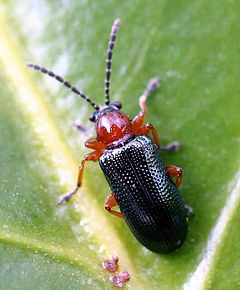
WOOSTER, Ohio – With fields beginning to dry out from the excessive rains experienced throughout the state and as temperatures begin to warm, crop growers should look to scout their fields for insects that have the potential to cause economic losses, an entomologist with Ohio State University’s College of Food, Agricultural, and Environmental Sciences said.
In addition to cereal leaf beetle, alfalfa weevil and black cutworm, crop growers need to be on the lookout for slugs, especially in fields with a history of slug damage, said Andy Michel, an Ohio State University Extension pest expert.
Heavy slug feeding
The region is likely entering into a period of heavy slug feeding, so corn and soybean growers need to be out inspecting their crops for the slimy pests, said Michel, who also has an appointment with the Ohio Agricultural Research and Development Center.
The slug issue is exacerbated by the cooler, wet weather experienced throughout the region this spring, which has caused delayed planting, he said.
“Slugs could be worrisome this year because we’ve had a lot of moisture and they are at their heavy feeding stage,” he said. “We’ve got a lot of crops that are just getting in the ground or just emerging, which is when they are most susceptible.
“Delayed planting is impacting the ability of the plants to withstand some of the pest damage.”
Management options are more limited for slugs, Michel said.
This OSU fact sheet slugs in field crops gives you more information.
“While slugs aren’t really widespread, those fields with history of slugs will likely continue to have slug issues,” he said.
“This is significant because slugs have a high potential to contribute to significant yield loss for corn and soybeans.”
Other pests
Some of the other invasive and damaging pests that growers can expect this year include:
• Alfalfa weevil: This pest has been spotted on several fields this spring, with some of the fields approaching threshold. Those growers can make their first cutting of alfalfa, which is recommended over insecticide applications when large numbers of alfalfa weevil have infested taller alfalfa. Alfalfa 12 inches long with greater than two weevils per plant or alfalfa 16 inches long with greater than four weevils, could be harvested early to avoid further damage.
“With the rain that we’ve had this spring and the rapid alfalfa growth, some growers may be able to cut early for alfalfa weevil rather than spray,” Michel said.
• Black cutworm: A record flight of this pest has been reported by Purdue University. Therefore, corn growers should start scouting their fields with corn that is emerging or has come up, for cutworm activity. Growers need to pay extra attention to those fields conducive to cutworm problems, such as no-till and or weedy fields.
“Black cutworm has the potential to be a big problem this year,” Michel said. “Some growers may count on seed treatments or Bt hybrids for control, but seed treatments alone won’t control cutworm, and not all Bt events work on cutworm.
“So some growers may think they are protected when they aren’t.”
More information on black cutworm can be found at ohioline.osu.edu/ent-fact/pdf/0035.pdf or extension.entm.purdue.edu/pestcrop/2014/issue6/index.html#moths.
• Cereal leaf beetle on wheat: Both adult cereal leaf beetles and eggs were spotted in some wheat fields last week, which is a concern as both adults and larvae can cause defoliation.

However, since larvae can do the most damage, growers should scout their fields for larvae, which are small, black, and resemble bird droppings.
Heavily infested fields will have a frosty appearance due to the type of feeding this pest does. Growers statewide should check their fields and those who spot an average of two or more larva per stem should treat their fields with insecticides to prevent yield loss.











As such, it is the pesticide of choice for many organic farmers across the
world. Antss should also be cooked because they caan pinch
with their mandibles. It also destroys insects themselves by clogging their breathing
holes.